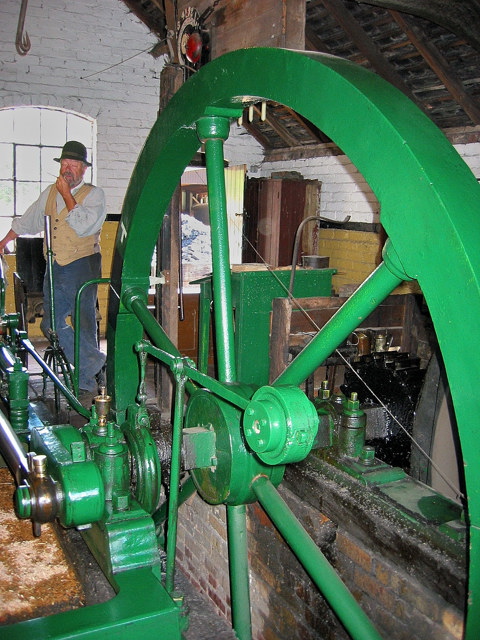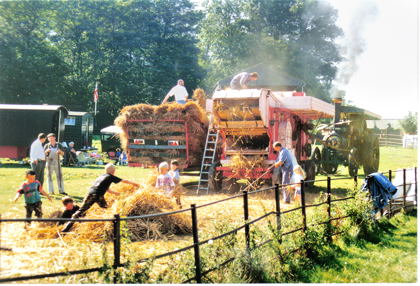| Home | Newsletter | Locations | Diary |
|
Indexes |
|
|
|
Article Technological Developments in
the
|
 |
A fundamental change in working principles was
brought about by James Watt. With the close collaboration of Matthew Boulton,
he had succeeded by 1778 in perfecting his steam engine, which incorporated
a series of radical improvements, notably the closing off of the upper part
of the cylinder thereby making the low pressure steam drive the top of the
piston instead of the atmosphere, use of a steam jacket and the celebrated
separate steam condenser chamber. All this meant that a more constant
temperature could be maintained in the cylinder and that engine efficiency
no longer varied according to atmospheric conditions. These improvements
increased engine efficiency by a factor of about five, saving 75% on coal
costs. Nor could the atmospheric engine be easily adapted to drive a rotating wheel, although Wasborough and Pickard did succeed in doing so towards 1780. However by 1783 the more economical Watt steam engine had been fully developed into a double-acting rotative type, which meant that it could be used to directly drive the rotary machinery of a factory or mill. Both of Watt's basic engine types were commercially very successful, and by 1800, the firm Boulton & Watt had constructed 496 engines, with 164 driving reciprocating pumps, 24 serving blast furnaces, and 308 powering mill machinery, most of the engines generated from 5 to 10 hp (7.5 kW). |
The development of machine tools, such as the lathe, planing and shaping machines powered by these engines, enabled all the metal parts of the engines to be easily and accurately cut and in turn made it possible to build larger and more powerful engines.
Until about 1800, the most common pattern of a steam engine was the beam engine, built as an integral part of a stone or brick engine-house, but soon various patterns of self-contained portative engines (readily removable, but not on wheels) were developed, such as the table engine. Towards the turn of the 19th century, the Cornish engineer Richard Trevithick, and the American, Oliver Evans began to construct higher pressure non-condensing steam engines, exhausting against the atmosphere. This allowed an engine and boiler to be combined into a single unit compact enough to be used on mobile road and rail locomotives and steam boats.
In the early 19th century after the expiration of Watt's patent, the steam engine underwent many improvements by a host of inventors and engineers.
Chemicals
The large scale production of chemicals was an important development during the Industrial Revolution. The first of these was the production of sulphuric acid by the lead chamber process invented by the Englishman John Roebuck (James Watt's first partner) in 1746. He was able to greatly increase the scale of the manufacture by replacing the relatively expensive glass vessels formerly used with larger, less expensive chambers made of riveted sheets of lead. Instead of making a small amount each time, he was able to make around 100 pounds (50 kg) in each of the chambers, at least a tenfold increase.
The production of an alkali on a large scale became an important goal as well, and Nicolas Leblanc succeeded in 1791 in introducing a method for the production of sodium carbonate. The Leblanc process was a reaction of sulphuric acid with sodium chloride to give sodium sulphate and hydrochloric acid. The sodium sulphate was heated with limestone (calcium carbonate) and coal to give a mixture of sodium carbonate and calcium sulphide. Adding water separated the soluble sodium carbonate from the calcium sulphide. The process produced a large amount of pollution (the hydrochloric acid was initially vented to the air, and calcium sulphide was a useless waste product). Nonetheless, this synthetic soda ash proved economical compared to that from burning certain plants (barilla) or from kelp, which were the previously dominant sources of soda ash and also to potash (potassium carbonate) derived from hardwood ashes.
These two chemicals were very important because they enabled the introduction of a host of other inventions, replacing many small-scale operations with more cost-effective and controllable processes. Sodium carbonate had many uses in the glass, textile, soap, and paper industries. Early uses for sulphuric acid included pickling (removing rust) iron and steel, and for bleaching cloth.
The development of bleaching powder (calcium hypochlorite) by Scottish chemist Charles Tennant in about 1800, based on the discoveries of French chemist Claude Louis Berthollet, revolutionised the bleaching processes in the textile industry by dramatically reducing the time required (from months to days) for the traditional process then in use, which required repeated exposure to the sun in bleach fields after soaking the textiles with alkali or sour milk. Tennant's factory at St Rollox, North Glasgow, became the largest chemical plant in the world.
In 1824 Joseph Aspdin, a British bricklayer turned builder, patented a chemical process for making portland cement which was an important advance in the building trades. This process involves interring a mixture of clay and limestone to about 1400 °C, then grinding it into a fine powder which is then mixed with water, sand and gravel to produce concrete. Portland cement was used by the famous English engineer Marc Isambard Brunel when constructing the Thames Tunnel, opened 1843, the world's first underwater tunnel. Cement was used on a large scale in the construction of the London sewerage system a generation later.
Machine tools
The Industrial Revolution could not have developed without machine tools, for they enabled manufacturing machines to be made. They have their origins in the tools developed in the 18th century by makers of clocks and watches and scientific instrument makers to enable them to batch-produce small mechanisms. The mechanical parts of early textile machines were sometimes called 'clock work' because of the metal spindles and gears they incorporated. The manufacture of textile machines drew craftsmen from these trades and is the origin of the modern engineering industry.
Machines were built by various craftsmen - carpenters made wooden framings, and smiths and turners made metal parts. A good example of how machine tools changed manufacturing took place in Birmingham, England, in 1830. The invention of a new machine by Joseph Gillott, William Mitchell and James Stephen Perry allowed mass manufacture of robust, cheap steel pen nibs, the process had been laborious and expensive. Because of the difficulty of manipulating metal and the lack of machine tools, the use of metal was kept to a minimum. Wood framing had the disadvantage of changing dimensions with temperature and humidity, and the various joints tended to rack (work loose) over time. As the Industrial Revolution progressed, machines with metal frames became more common, but they required machine tools to make them economically. Before the advent of machine tools, metal was worked manually using the basic hand tools of hammers, files, scrapers, saws and chisels. Small metal parts were readily made by this means, but for large machine parts, production was very laborious and costly.
Apart from workshop lathes used by craftsmen, the first large machine tool was the cylinder boring machine used for boring the large-diameter cylinders on early steam engines. The planing machine, the slotting machine and the shaping machine were developed in the first decades of the 19th century. Although the milling machine was invented at this time, it was not developed as a serious workshop tool until during the Second Industrial Revolution.
Military production had a hand in the development of machine tools. Henry Maudslay, who trained a school of machine tool makers early in the 19th century, was employed at the Royal Arsenal, Woolwich. As a young man he would have seen the large horse-driven wooden machines for cannon boring made and worked by the Verbruggans. He later worked for Joseph Bramah on the production of metal locks, and soon after he began working on his own. He was engaged to build the machinery for making ships' pulley blocks for the Royal Navy in the Portsmouth Block Mills. These were all metal and were the first machines for mass production and making components with a degree of interchange ability. The lessons Maudslay learned about the need for stability and precision he adapted to the development of machine tools, and in his workshops he trained a generation of men to build on his work, such as Richard Roberts, Joseph Clement and Joseph Whitworth.
James Fox of Derby had a healthy export trade in machine tools for the first third of the century, as did Matthew Murray of Leeds. Roberts was a maker of high-quality machine tools and a pioneer of the use of jigs and gauges for precision workshop measurement.
Gas lighting
Another major industry of the later Industrial Revolution was gas lighting. Though others made a similar innovation elsewhere, the large scale introduction of this was the work of William Murdoch, an employee of Boulton and Watt, the Birmingham steam engine pioneers. The process consisted of the large scale gasification of coal in furnaces, the purification of the gas (removal of sulphur, ammonium, and heavy hydrocarbons), and its storage and distribution. The first gas lighting utilities were established in London between 1812-20. They soon became one of the major consumers of coal in the UK. Gas lighting had an impact on social and industrial organisation because it allowed factories and stores to remain open longer than with tallow candles or oil. Its introduction allowed night life to flourish in cities and towns as interiors and streets could be lighted on a larger scale than before.
Effects on agriculture
The invention of machinery played a big part in driving forward the British Agricultural Revolution. Agricultural improvement began in the centuries before the Industrial Revolution got going and played a part in freeing up labour from the land to work in the new industrial mills of the 18th century. As the revolution in industry progressed a succession of machines became available which increased food production with ever fewer labourers.
Jethro Tull's seed drill invented in 1731 was a mechanical seeder which distributed seeds efficiently across a plot of land. Joseph Foljambe's Rotherham plough of 1730, was the first commercially successful iron plough. Andrew Meikle's threshing machine of 1784 was the final straw for many farm labourers, and led to the 1830 Agricultural Rebellion or the Swing Riots.
| In the 1850s and '60s John Fowler, an engineer and inventor, began to look at the possibility of using steam engines for ploughing and digging drainage channels. The system that he invented involved either a single stationary engine at the corner of a field drawing a plough via sets of winches and pulleys, or two engines placed at either end of a field drawing the plough backwards and forwards between them by means of a cable attached to winches. Fowler's ploughing system vastly reduced the cost of ploughing farmland compared with horse-drawn ploughs. Also his ploughing system, when used for digging drainage channels, made possible the cultivation of previously unusable swampy land. The traction engine later became a common sight and working threshing machines during haymaking time and ploughing fields. |
 |
This article is based partly on extracted information from Wikipedia.
| By: Keith Park | Section:
Heritage Section
|
Key: |
| Page Ref: industrial_revolution_technology | Topic:
Industrial
|
Last Updated: 09/2009 |
|
This page: |
Link directly to this page, with text or the button on right. Text linking: Technological Developments in the Industrial Revolution on Photographers Resource Linking Instructions http://www.photographers-resource.co.uk/ |
|